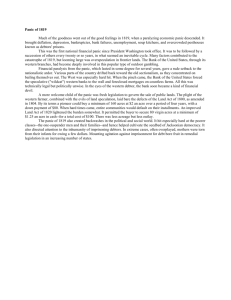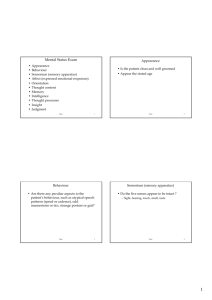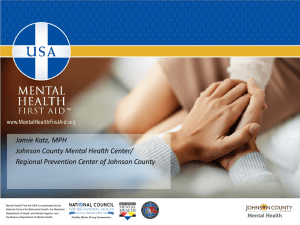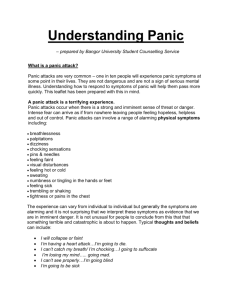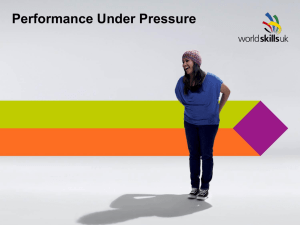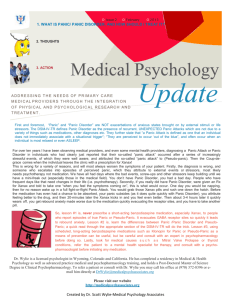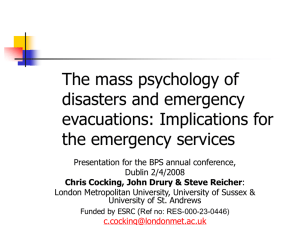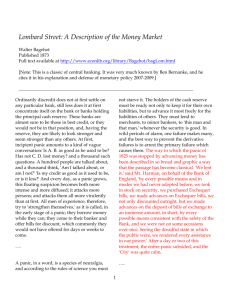Tips for Coping with Panic Attacks
advertisement
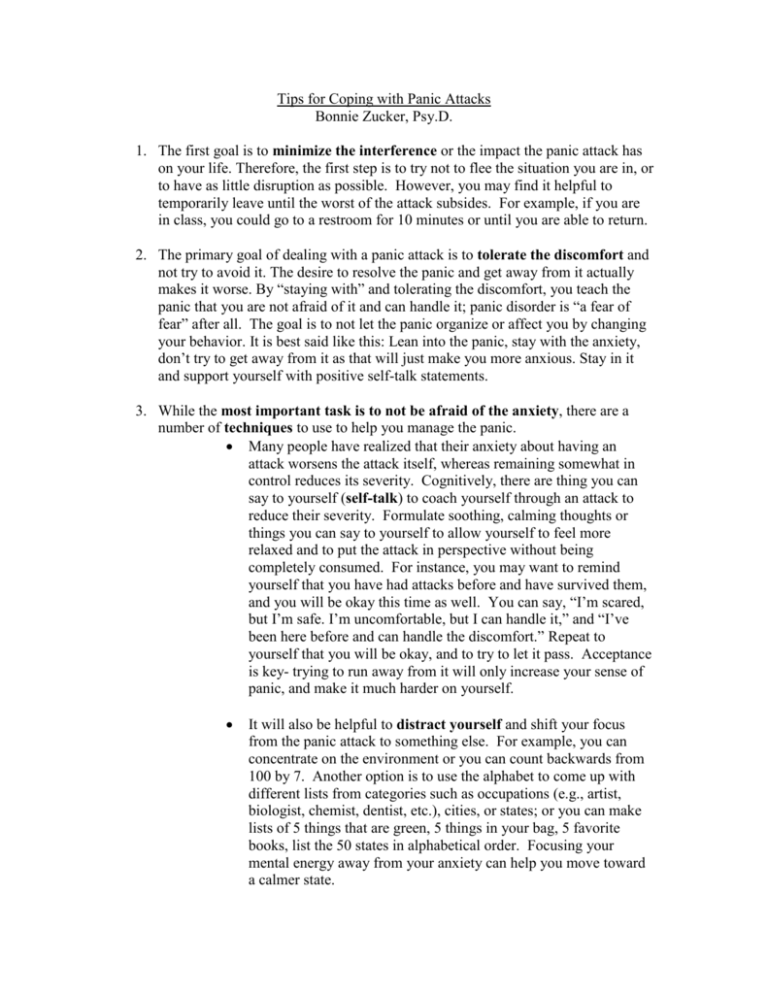
Tips for Coping with Panic Attacks Bonnie Zucker, Psy.D. 1. The first goal is to minimize the interference or the impact the panic attack has on your life. Therefore, the first step is to try not to flee the situation you are in, or to have as little disruption as possible. However, you may find it helpful to temporarily leave until the worst of the attack subsides. For example, if you are in class, you could go to a restroom for 10 minutes or until you are able to return. 2. The primary goal of dealing with a panic attack is to tolerate the discomfort and not try to avoid it. The desire to resolve the panic and get away from it actually makes it worse. By “staying with” and tolerating the discomfort, you teach the panic that you are not afraid of it and can handle it; panic disorder is “a fear of fear” after all. The goal is to not let the panic organize or affect you by changing your behavior. It is best said like this: Lean into the panic, stay with the anxiety, don’t try to get away from it as that will just make you more anxious. Stay in it and support yourself with positive self-talk statements. 3. While the most important task is to not be afraid of the anxiety, there are a number of techniques to use to help you manage the panic. Many people have realized that their anxiety about having an attack worsens the attack itself, whereas remaining somewhat in control reduces its severity. Cognitively, there are thing you can say to yourself (self-talk) to coach yourself through an attack to reduce their severity. Formulate soothing, calming thoughts or things you can say to yourself to allow yourself to feel more relaxed and to put the attack in perspective without being completely consumed. For instance, you may want to remind yourself that you have had attacks before and have survived them, and you will be okay this time as well. You can say, “I’m scared, but I’m safe. I’m uncomfortable, but I can handle it,” and “I’ve been here before and can handle the discomfort.” Repeat to yourself that you will be okay, and to try to let it pass. Acceptance is key- trying to run away from it will only increase your sense of panic, and make it much harder on yourself. It will also be helpful to distract yourself and shift your focus from the panic attack to something else. For example, you can concentrate on the environment or you can count backwards from 100 by 7. Another option is to use the alphabet to come up with different lists from categories such as occupations (e.g., artist, biologist, chemist, dentist, etc.), cities, or states; or you can make lists of 5 things that are green, 5 things in your bag, 5 favorite books, list the 50 states in alphabetical order. Focusing your mental energy away from your anxiety can help you move toward a calmer state. You can try to engage in relaxation exercises to lessen the severity of the attack. There are three main relaxation techniques you can use: deep breathing, progressive muscle relaxation (PMR), and imagery. For breathing, remember that the goal is to take slow, deep breaths and that this can be accomplished by breathing through your nose for 5 seconds, holding your breath for 20 seconds, and slowing breathing out of your mouth for 10 seconds. Do this several times, allowing about 1 minute between each pattern. While you are holding your breath, the oxygen is invigorating your blood, which will result in a more alert, energized state. You can also do 1-nostril breathing where you breathe in and out through only one nostril (close your mouth and hold other nostril closed), for the count of 10 in and the count of 10 out, for a full 5 minutes. PMR involves tensing and releasing each muscle group, starting with the hands, moving up through the arms, torso, shoulders, head, buttocks, legs, and feet. Imagery entails picturing a scene that feels safe and serene and visualizing yourself in that scene. Practicing breathing, PMR and imagery during non-panic states will prepare you to use them effectively in panic states. 4. Maintenance factors are how we should all manage stress. They vary from individual to individual, however, those that apply to most people include: -eating well-balanced, non-inflammatory, non-sugar meals with good nutritional value; limiting or avoiding caffeine and nicotine -sleeping regularly; consistent patterns of sleep -regular cardiovascular exercise & yoga -nurturing your social needs, spending time with others -keeping up with work/school demands; getting behind causes stress -express your feelings; don't keep your emotions "in"

